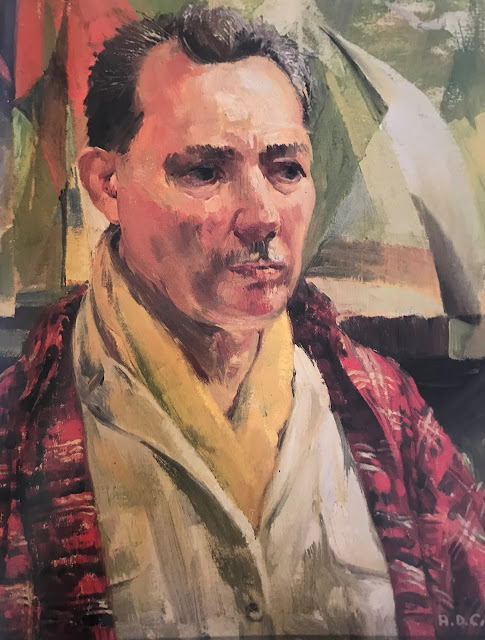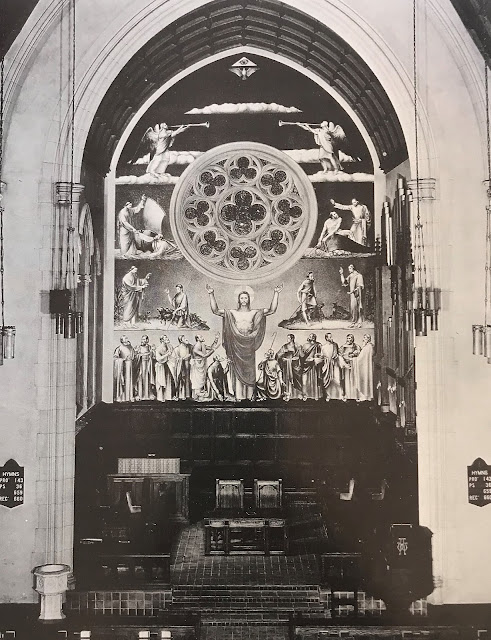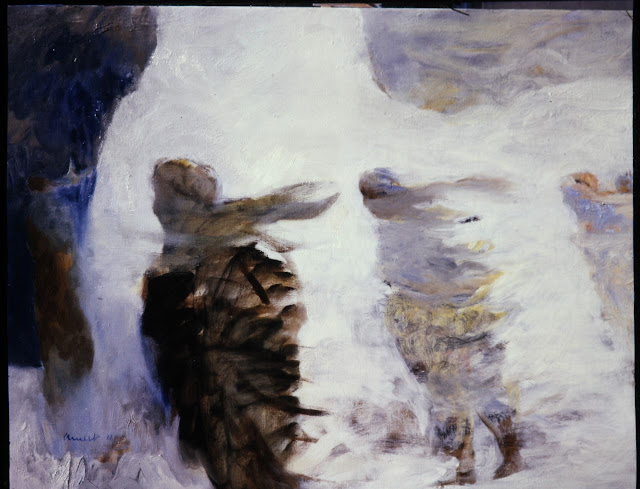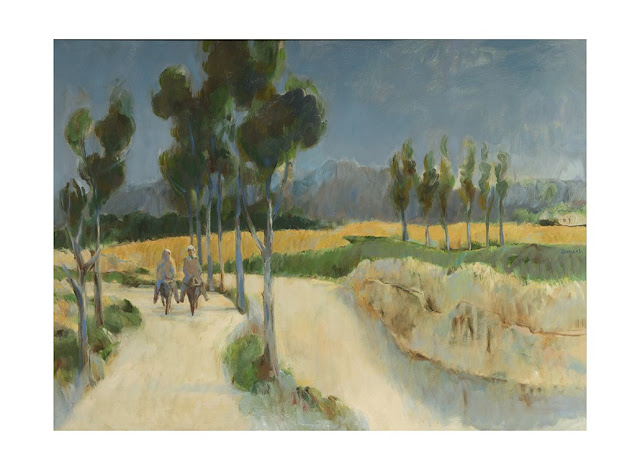Sometimes
in researching an artist whose career was aided by Quirk through an
exhibition one discovers amazing things. We helped a school in New York
discover James Penney had painted its previously unattributed WPA murals. We learned about the amazing VictoriaOakley and her working toward world peace. We helped draw attention to Joe Army's ground-breaking work in playground structures, where he revolutionized thinking on play. But one amazing wrinkle to the Alfred Crimi story could almost bring tears to one's
eyes.
Crimi would exhibit with Anna Quirk (Francis Quirk's wife) at Lehigh in 1963.
 |
| Alfred Crimi Self Portrait |
Biography of Alfred D. Crimi
 |
| Alfred Crimi |
Alfred D. Crimi was born in San
Fratello, in the province of Messina, Sicily, on December 1, 1900. He was the
eighth of eleven children born to Filadelfio Crimi and Maria di Giorgio. He
attended school in San Fratello and at the age of eight, his parents sent him
for a few hours after school to a furniture maker to learn a trade. In 1910, the
Crimi family emigrated to America.
They embarked from the port of
Palermo, and traveled steerage for thirteen days until they arrived in New
York. For the first three years he lived and went to school in East Harlem. It
was during this period that young Crimi was inspired to become an artist. He
began his formal training in art at the National Academy of Design, New York
City. In 1924, lived in Greenwich Village, renting a studio at West 14th
Street. While there, he won the Suydon Gold and Silver Medals for drawing from
life, in addition to other prizes for which he competed. Adding to his academic
training, Crimi studied for one year at the Beaux Art, being honored with the
Tiffany Fellowship. Crimi’s first one-man show in drawing was at the Babcock
Galleries in 1928. He then exhibited at various places including the National
Academy of Design, the Sesqui-Centennial in Philadelphia, and the Ferargil
Galleries. In 1929, he returned to Italy to continue his art studies. In Rome, he
attended the Scuola Preparatoria Alle Arti Ornamentali where he studied the art
of fresco and Pompeian encaustic as well as perspective drawing. At the end of
his studies, he received a diploma and was awarded first prize for fresco
painting. After graduation, he left Rome by train, to return to San Fratello.
During his sojourn in San
Fratello, he painted several canvases and during the remainder of time he
visited the cathedrals of Palermo, Cefalu, and Monreale – masterpieces of
Norman-Byzantine art. Many years later, the cathedral of Monreale inspired his
painting “The Cathedral”, which is on display at the Griffiths Art Gallery, St.
Lawrence University, Canton, N.Y.
Crimi returned to the United
States in 1930 during the Great Depression. Crimi found a position in Portland,
Oregon, as a consultant in color decoration for a firm in New York City. After
several months in Oregon, he returned to New York and was engaged to teach art
at the John Reed Art School. (When he found out that the School was a front for
communist propaganda, he immediately resigned). During this time he
occasionally visited his brother Fred and his wife Sara, who were musicians.
Fred a violinist, and Sara, a pianist, frequently invite other musicians to
their home for chamber music sessions. It was at one of these gatherings that Crimi
met his future wife, Mary Timpone, a pianist. Mary, whose family had emigrated
from San Fratello, married Crimi in 1935.
On May 12, 1935, President
Roosevelt signed the Federal Emergency Relief Act and on December of the same year, through the newly organized Public Works of Art Project, he
received a commission to paint a fresco in the Open Air Aquarium, Key West,
Florida, which he completed in 1935. The fresco, with its vivid, vibrant
colors, was one of the main attractions of the Aquarium, and it showed Key West
fishermen unloading a catch of fish and a fishing vessel docking. The original mural was destroyed, but images of a replica can be found here.
In 1936, both Crimi and Mary
were employed on the Works Projects Administration (W.P.A.) – Mary as a piano
teacher, and Crimi as an artist in the mural division. His first assignment for
which he competed, was to paint a fresco for the Medical Board Room at Harlem
Hospital. The fresco was entitled “Modern Surgery and Anesthesia”. Interestingly, the mural depicted only white clinicians. You can learn more about the murals at the hospital here.
 |
| Selected section of "Modern Surgery and Anesthesia" mural by Alfred Crimi. |
 |
| Complete Black and White Image of "Modern Surgery and Anesthesia" a 1936 mural by Alfred Crimi.Work was funded by the WPA. |
Meanwhile,
he entered a competition for the main Post Office building in Washington, D.C.,
and out of more than three hundred entries submitted, he was chosen as one of
the six winners. The mural he completed “Parcel Post”, depicted a rural
railroad station with a loading platform and men loading and unloading mail.
 |
| "Parcel Post" mural by Alfred Crimi |
In 1935 he was invited to
become a member of the National Society of Mural Painters. In 1936 the Society
sponsored a nationwide competition for an eight hundred square feet mural for
the rear chancel wall of the Rutgers Presbyterian Church in New York City. Of the 20 entrants, the Crimi's design won the $6,800 commission for his
Spreading the Gospel.
The Sad Story
Crimi worked on the mural for
two years. Upon its unveiling on
November 20, 1938 the pastor, Dr. Daniel Russell, described it as a picture of
"the human Christ, whose muscles have hardened with the toil of rude and
heavy tools in a primitive carpenter shop." A large number of the female members
disagreed, finding it disturbing to look at the muscular naked torso of Christ
throughout the service.
Late in the summer of 1946
Crimi was in Manhattan and dropped into Rutgers Presbyterian Church to visit
his work. The Rome [New York] Sentinel
reported "he was horrified to find that it had been blotted out by the
church authorities." That mural had
been erased by a thick coating of white paint.
"It was explained by the
Rev. Dr. Ralph W. Key, the pastor, that members of the congregation felt the
central figure of Christ 'portrayed physical rather than spiritual
strength--they just didn't like it and when the church was redecorated the
mural was included in the plans."
 |
| The offending Spreading the Gospel. New York Post, March 11, 1947 |
Incensed and indignant, Crimi
went to court for damages. He admitted
to reporters that while "he could not legally force the church to restore
the mural, he would attempt to force the issue on moral grounds."
Crimi's case was
interesting. He said the church had
replaced his mural with "an undignified burial shroud" and asked the
courts to "protect his honor and reputation." (And grant him $50,000
as well.) To do so attorneys and a judge
would have to decide if such a thing as "moral ownership" existed.
It didn't.
After dragging on for years,
the courts ruled on January 29, 1949 that "when the picture has been
painted and delivered to the patron and paid for by him, the artist has no
right whatever left in it." Supreme Court Referee, Charles C. Lockwood,
ruled that the work had been “sold unconditionally” in 1938. You can see a more
detailed discussion of the case here.
Addendum
Since the initial publication of this post we have obtained a copy of Crimi's biography "My Life Story" and obtained better images of the mural. We have inserted them below.
 |
Chancel of Rutgers Presbyterian Church Mural by Alfred Crimi 1936-1938
|
 |
| Chancel of Rutgers Presbyterian Church Mural by Alfred Crimi 1936-1938 |
For the years 1939 and 1940,
under the WPA’s section of Painting and Sculpture, he was awarded through
national competition two additional mural commissions: “Work, Religion and
Education” for Northampton, Mass. Post Office, and “Anthony Wayne, General,
Surveyor, and Gentleman Farmer”, for Wayne, Pennsylvania, Post Office. These
murals were painted on oil canvas. In 1941 as the U.S. entered World War II,
all federally sponsored art projects were terminated; consequently, Crimi was
compelled to seek other employment.
 |
| "Anthony Wayne, General, Surveyor, and Gentleman Farmer” mural by Alfred Crime |
During the war, he went to work
for the Sperry Gyroscope, and was assigned in the Graphic Engineering
Department. In this department he was part of a team of artists doing
three-dimensional drawings of military weapons and other instruments from
engineers’ blueprints; these illustrations were reproduced in military training
manuals. Several of these drawings were also published by Life magazine,
the London Illustrated Sunday News and other industrial
publications. His work showed remarkable attention to detail and excellent draftsmanship.
 |
| Ball Turret Gunner Diagram executed by Alfred Crimi for Sperry in 1943. The Ball Turret was beneath a B-17bomber and a very dangerous position. |
It was during this period that the genesis of a multi-dimensional
painting began to take form. This method involves a combination of geometrical,
transparent, overlapping planes; the light is emitted by the whole painting,
different from the traditional method of light cast on subjects – the method of
chiaroscuro painting. Crimi later perfected this method and used it in many of
his paintings; he also wrote a book entitled The Art of Multi-Dimensional
Painting. This book may be purchased through Amazon.
After leaving Sperry, Crimi
returned to full-time easel painting and watercolor. However, before he resumed
his career as a creative artist, it was necessary that he reconcile his
training in the classical tradition, which progressed from realism to
expressionism, to abstractionism and to his new found method of
multi-dimensional principles of color animation. The first important painting
to come out of this period was the much acclaimed “Metropolis”, which is now in
the Wisteriahurst Museum of Holyoke, MA. The Painting uses rectangular and
abstract geometrical forms to represent a modern city.
In 1947, George Binet Gallery
in New York sponsored a one-man show. The exhibition was a retrospective of the
previous six years and demonstrated Crimi’s abundant capacity for handling
pictorial problems masterfully. It showed how Crimi worked his way through
strong-modeled, rounded forms, to pure abstraction. Among the painting
presented were “My Window”, “Polyphony”, “The Unconquered”, and “Meucci”. As a
result of this exhibition he was invited to teach at City College in the Adult
Education Program, lecturing on paintings, watercolor, and perspective drawing.
He also taught at the Pratt Institute in New York and Penn State University.
Among the subjects covered in his classes were “Fresco Painting in Terms of the
Present”, “The Making of Venetian Glass Mosaic”, “A Creative Approach to
Color”. Crimi’s film “The Making and Fascination of Fresco Painting” was
usually included in the curriculum.
During this time he became
member of several art societies, including National Society of Mural Painters,
Allied Artist of America, The Audubon Artists, The Federation of Modern
Sculptors and Painters, and others.
 |
| "City in Decay" by Alfred Crimi 1948 |
 |
| "Shutter Eye" by Alfred Crimi 1960 |
Spaces and Planes #1" by Alfred Crimi 1950
 |
| Alfred Crimi Painting |
 |
| Alfred Crimi Painting |
In 1949, he held a successful
one-man show at the Ferargil Galleries in New York City. Ferargil also handled
other well-known artists including Grant Wood and Thomas Hart Benton. The show received effusive
praise from the critics; “Jewel-like” was the term used by a critic for several
of his oil paintings. In 1956 he won The Emily Lowe Prize for his painting
entitled “The Three Mary’s”, depicting the Annunciation. Later that year, he
returned to the Village renting a new studio on 13th Street. The following year
he held an exhibition at the World Eggleston Gallery on Madison Avenue. Among
the paintings presented were: “Metropolis”, “Dead City”, “Out of Space-Out-of
Time”, and “Rigging”. The critics gave good critical reviews but were confused
with the diversity of styles. Crimi was essentially a mural painter who had
turned to easel painting. However, he relentlessly experimented with new
mediums, in order to more fully and originally express himself, going from
realism to multi-dimensional techniques and to abstraction.
In 1959 he held a one-man
exhibition at the Two Selected Artists Gallery in New York. This exhibition
consisted mainly of works of the multi-dimensional style, and it included “The
Cathedral”, which had been inspired by the Byzantine Cathedral in Monreale
(Sicily). In 1962 the Holyoke Museum in that Massachusetts town sponsored a
one-man exhibition of Crimi’s works. Then in April 1963, his artwork was
highlighted in an exhibit at Lehigh University Art Galleries organized by
Francis Quirk. This was followed by an exhibition
sponsored by Fordham University, New York in 1966, one at Temple Emeth in
Teaneck, New Jersey, in 1969, and another in 1971 at the Ringwood Manor Museum,
Ringwood, New Jersey. Moreover, he exhibited in major national and
international group shows including New York City’s Whitney Museum, Museum of
Modern Art, and Metropolitan Museum of Art, The Chicago Art Institute, and The
Cerneschi Art Gallery in Paris. In 1961 he was invited to participate in the
Prima Mostra Internazionale d’Arte Sacra in Trieste, Italy, and in 1972 at the
Cerneschi Art Gallery of Paris. He served during the years 1958-1961 with the
Art Commission of the City of New York. When his three years term ended he
returned to mural work while continuing easel painting. During the next ten
years he was engaged by the Board of Education to execute five Venetian glass
mosaics in New York City Schools – including those of Adlai Stevenson High
School, Albert Einstein Jr. High School, and Public School 377.
Crimi was the recipient of more
than forty awards from numerous art organizations. His articles on fresco
painting, mosaics, and the multi-dimensional principle of color animation,
appeared in American Artist, Today’s Art, Liturgical Art, and the Book of
Knowledge.
After 18 years, he had to
vacate the studio at West 13th Street, New York City. He rented another studio
on West 4th Street, but left in 1978, after a 1976 flood that damaged several
of his paintings and led to litigation against the landlord, he left.
His last one-man exhibition was
sponsored by the Ulrich Museum of Wichita State University and featured
predominantly his multi-dimensional paintings. Simultaneously, he received
first prize in graphics for his famous “Mediterraneum Noon” from an exhibition
sponsored by the Associated Galleries of West New York.
During the early 1980s the
Crimis moved to a new apartment near the New York Botanical Garden in the
Bronx, New York, where Alfred Crimi expanded his artistic skills yet again,
doing a series of watercolors of the garden. Crimi died on January 7, 1994.
In researching this article we have learned that a number of Crimi paintings were deaccessioned by the Musuems at St. Laurence and Wichita State. We do not know if they still hold any of his works. There still are Crimi paintings at the Smithsonian.
If you are interested in adding a Crimi painting to your collection, then you are in luck! A fine one will be coming up for auction in Connecticut in late April. You can bid on it here. One can see how it has the feel of a mural.
 |
| "New York Harbor" by Alfred Crimi |




































